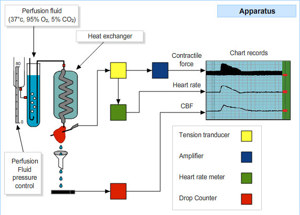Langendorff Heart
By David Dewhurst & Malachy Doherty
| Record number: | a31f5 (legacy id: 125) |
|---|---|
| Category: | Pharmacology - Physiology |
| Type: | Computer Program |

A computer simulation of experiments which may be performed on the isolated, perfused mammalian heart.
This program is highly interactive and simulates experiments, which may be performed on the isolated perfused mammalian heart (Langendorff preparation). Introduction and Methods sections cover the removal of the heart , setting it up to record ventricular contractile force, heart rate and coronary blood flow and the administration of drugs.
In the Experiments section simulated data, derived from actual data, is presented on a screen display which emulates a chart recorder. Students 'design' experiments by choosing, from a menu, a range of pharmacological agents which may be administered either alone, or in combination with an antagonist or potentiator. Each trace represents several minutes of recording and thus allows students to access a large amount of data in a short period of time. A facility to compare traces of 'drug X alone' with drug X + antagonist Y or drug X + potentiator Z is available. This allows easy visual comparison of qualitative effects and of course more accurate measurements can be taken from the screen.
The program covers:
- effects of drugs: sympathomimetics (adrenaline, noradrenaline, salbutamol, clonidine, phenyl-ephrine, dobutamine) antagonists (propranolol, yohimbine atenolol, prazosin, butoxamide, phentolamine) potentiators (cocaine); parasympathomimetics (acetylcholine, carbachol, methacholine, nicotine) antagonists (atropine, amitryptyline, hexamethonium) potentiator (neostigmine); cardiac glyco-sides (digoxin, ouabain); coronary vasodilators (nitrogly-cerine, adenosine (antagonists: theophylline, dipyridamole), histamine (antagonists: cimetidine, mepyramine), verapamil;
- effect of ions: (high and low concentrations of calcium, potassium and sodium);
- effect of increasing pre-load on contractile (ventricular) force (Starlings Law).
The simulated responses (heart rate, ventricular force and coronary blood flow) are derived from actual experimental data and presented in high resolution colour graphics in a form comparable to that of a chart recorder. The program contains textual information describing the preparation and experimental method and an editable on screen help facility allows teachers to tailor the information-content of the program to specific groups of students. The package also includes suggested student assignments.
It is envisaged that the program could be used in a number of ways: to better prepare students who will the perform the practical at a later date; to debrief students after they have performed the practical; as a 'fallback' to provide data for students whose experiments were unsuccessful; as an alternative to the practical, though it should be remembered that different learning objectives may be achieved.
ISBN: 1-874758-09-3
Language: English
Recommended System Requirements:
Safari 5.0 or later, Mozilla Firefox 4.0 or later, Google Chrome or Edge
Target Audience:
Particularly suitable for undergraduate students from a range of biological science, medical and health-related courses.
Price: £250 (multiuser, educational licence)
Free of charge Loan Program: Free of charge
On loan On Loan
Product reviews Reviewed
Thanks for your feedback! Please note that we cannot reply to you unless you send us an email.
What are you looking for?
We value your feedback so we can improve the information on the page. Please add your email address if you would like a reply. Thank you in advance for your help.!
Please contact us by email if you have any questions.
